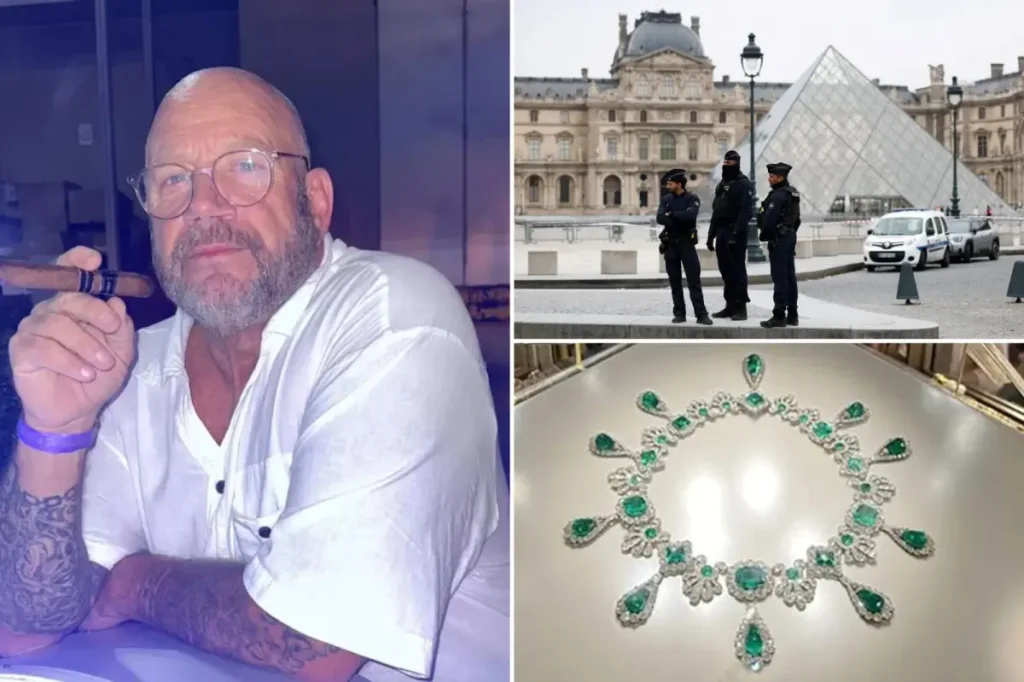Loot in the Booty: The Louvre Heist and Insights from America’s Most Notorious Jewel Thief
In a shocking revelation about the recent $102 million Louvre Museum jewelry heist, America’s most infamous jewelry thief suggests the perpetrators may have employed an unexpected smuggling technique. Larry Lawton, who stole an estimated $18 million from 25 jewelry stores along the East Coast during the ’80s and ’90s, shared his professional assessment with The Post. According to Lawton, the thieves may have resorted to hiding the precious items in their rectums to transport them out of France. “Believe it or not, depending on the size, you could take some of that jewelry apart and literally ‘suitcase’ it,” Lawton explained, using the criminal slang term for concealing items internally. Drawing from his own experience, the reformed criminal shared that human anatomy allows for such concealment—a technique he claims to have personally employed in his criminal past, graphically describing how smaller valuables can be hidden using modified everyday items like travel toothbrush holders.
The 64-year-old ex-con doesn’t seem impressed with the Louvre thieves’ professionalism, repeatedly describing them as “amateurs” and “idiots” based on their numerous mistakes. While Lawton prided himself on meticulous planning and flawless execution during his criminal career, the Louvre bandits left behind damning evidence—including a glove at the crime scene, damage to the historic Empress Eugenie’s imperial crown that was dropped during their hasty escape, and a failed attempt to destroy evidence by setting fire to their getaway vehicles. “They’re not professionals like I was,” Lawton stated emphatically. “I robbed 25 stores and I never dropped the jewelry, no less a crown!” Because of these errors, he believes authorities will eventually identify and apprehend the thieves, even if they’ve temporarily escaped France with their valuable haul.
Lawton offered insight into what might have been the inside story behind the heist, suggesting that at least one of the robbers likely has connections to the Louvre. Drawing from his own criminal methodology, he explained that serious planning goes into every major robbery. During his criminal career, he “cased over 1000 jewelry stores” before selecting just 25 to actually rob. Lawton even shared details about an elaborate heist he planned at Miami Beach’s Fontainebleau Hotel involving fake dynamite and hostage-taking—a plan he ultimately abandoned. “Thank God I didn’t do it,” he admitted. This level of preparation stands in stark contrast to the apparently less professional Louvre theft, further supporting Lawton’s assessment that these thieves lacked sophisticated criminal experience.
Despite their mistakes, Lawton understands the psychological state the thieves experienced during and after the heist. “You are juiced,” he explained, describing the adrenaline rush that comes with successfully executing a robbery. “I’ve done every drug in the book, but there’s no high like walking out of a jewelry store knowing you got $1 million in a bag.” However, the thrill of the heist is only the beginning. Lawton emphasized that the most crucial aspect of jewelry theft is having reliable fences to sell the stolen goods. Given the historical significance and uniqueness of the Louvre items, he believes the thieves may struggle to offload them, even if they’re disassembled. This difficulty in converting the stolen goods to cash compounds the risks the thieves have already taken through their sloppy execution.
While Lawton characterizes the jewelry business as “a scumbag business,” popular culture has often romanticized jewel thieves through films like “To Catch a Thief,” “Hot Rock,” and “Ocean’s 8.” Real-life jewelry thieves have sometimes seemed equally cinematic in their approaches. Joan Hannington, known as “The Godmother,” gained notoriety in 1980s London for swallowing jewels to smuggle them out of stores, eventually inspiring a television miniseries starring Sophie Turner. Olivera “Olja” Ćirković, a former Serbian basketball player who became part of the international Pink Panthers jewel thief network, masterminded several robberies in Greece before spending five years in prison. These colorful characters demonstrate how the reality of jewelry theft can sometimes rival its fictional portrayals.
Other notable jewel thieves include the infamous “Diamond Doris” Payne, whose criminal career spanned decades—she was still active at age 80 when arrested for stealing a diamond ring from Macy’s in 2011. Then there’s Jack Murphy, nicknamed “Murph The Surf,” who participated in the legendary 1964 American Museum of Natural History burglary, stealing 24 precious gems in what became known as “the Jewel Heist of the Century.” Murphy’s life even inspired a 1975 film titled “Live A Little, Steal A Lot.” These figures represent the more glamorous side of jewelry theft, contrasting with Lawton’s harsh assessment of the Louvre thieves. While the Louvre heist perpetrators may have temporarily succeeded in stealing $102 million worth of historical treasures, their legacy, according to one of America’s most successful jewelry thieves, will likely be one of amateur mistakes rather than criminal brilliance—proving that not all who steal jewels deserve a place in the pantheon of notorious gem thieves.















